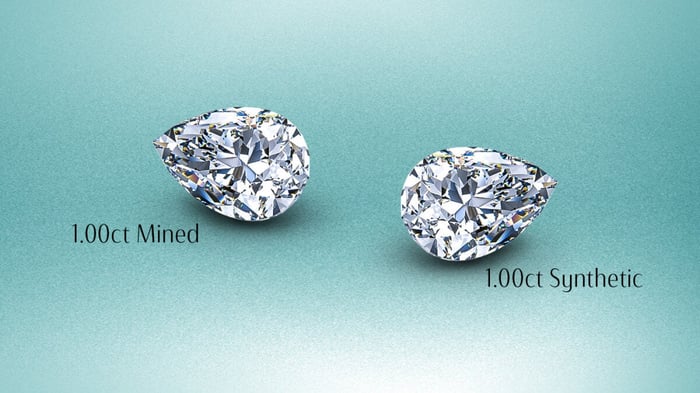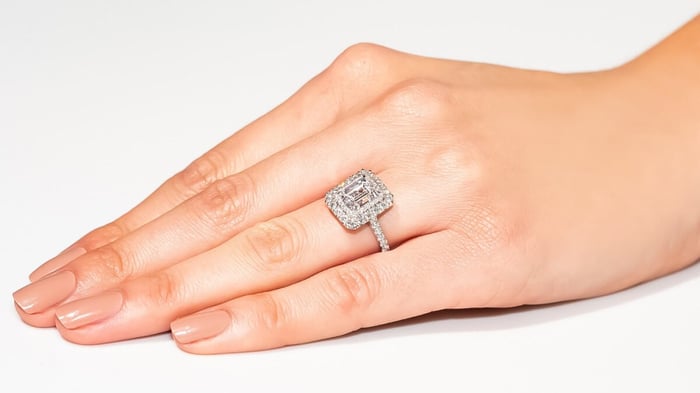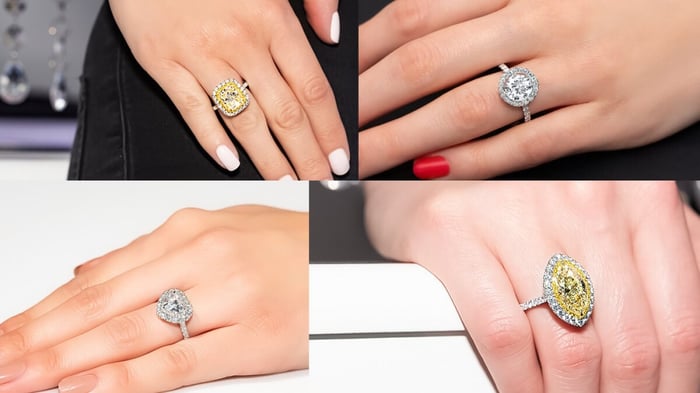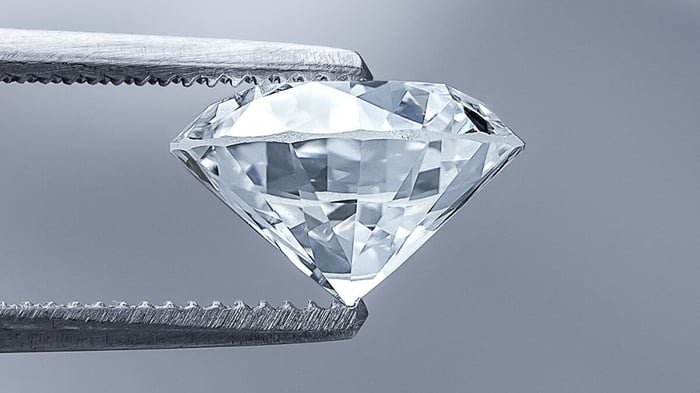Are Lab Created Diamonds Worth Anything?
A lab created diamond is a real diamond, physically and chemically identical to natural diamonds from one of the world's diamond mines. It is tough to tell synthetic diamonds apart from natural, mined, diamonds. There are also diamond simulants, or fake diamonds which are not the same as natural diamonds, examples of diamond simulants are cubic zirconia, synthetic moissanite, or white topaz. There is no doubt that these fake diamonds have very little value in comparison with the real thing and many respectable jewellers refuse to sell such stones.
Lab created diamonds are sometimes called synthetic diamonds, there is no difference, except that the mined diamond industry prefers the term 'synthetic diamonds' as they believe it cheapens the lab created product and tends to lead to confusion between the fake diamond simulants and lab-grown genuine diamonds.
Lab created diamonds do have value, when sold as jewellery they tend to sell at a discount of 30-40% to an equivalent mined diamond. According to Reuters, the price gap between lab-grown and mined diamonds is increasing. In November 2018 the premium for natural diamonds had risen to 42%, up from just 29% in January of that year.[1]
Since the first synthetic diamonds were created in 1947, De Beers, the largest diamond producer and trader had refused to sell synthetic diamonds as jewellery, but as the production of the lab-grown synthetic product had grown there was a danger that the synthetic product might even start to replace mined diamonds as the first choice of jewellery buyers. The economic case for buyers of diamond jewellery was simple: if a one carat mined diamond sold for £4,800 the synthetic equivalent would cost just £3,300.

De Beers chose to sell synthetic diamonds for just £635 per carat but only for use in costume jewellery and without any form of certification. The company’s goal in doing this was to undercut the prices of other suppliers of lab-grown diamonds and to cultivate a distinction between synthetic diamonds and natural diamonds so that customers would reject the synthetic version in favour of mined diamonds for major jewellery purchases such as diamond engagement rings. The policy seems to be working as the retail price of lab-grown diamonds, in general, is falling toward the £635 per carat of the De Beers synthetic gems.
Do Lab Created Diamonds Have Benefits Over Mined Diamonds?
The advantages of lab created diamonds are related to their lower price. One can buy a larger synthetic gem than a mined diamond at any given price and, generally speaking, the synthetic stone will be more perfect, less flawed. Apart from the De Beers synthetic diamonds, a lab-grown diamond can have its own gemmological report covering the same 4Cs, colour, clarity, cut and carat weight as a mined stone. The reports are provided by the same assessment laboratories as for mined stones. The assessment report states if the stone is lab-grown to avoid confusion. Synthetic diamonds can be created in a range of fancy colours that would be considered very rare in nature, but at a price that is much lower than the natural equivalent. This increases the opportunities for ring designers to wow clients with stunning designs at a very reasonable cost.
Synthetic diamonds can be created in a range of fancy colours that would be considered very rare in nature, but at a price that is much lower than the natural equivalent. This increases the opportunities for ring designers to wow clients with stunning designs at a very reasonable cost.
18 Stone Half Eternity Ring 0.20ct G/SI Diamonds in Platinum
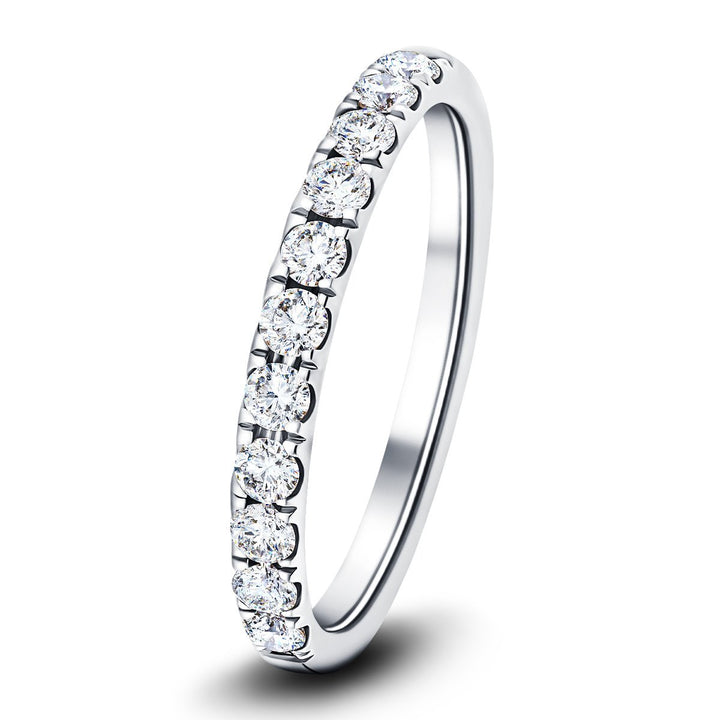
£647.00
£997.00
A delicate and elegant half eternity ring in the brilliant UK Hallmarked platinum. Eighteen hand-cut diamonds of G/SI quality and certified as conflict-free will sparkle and shine in any setting from London to Los Angeles and everywhere in between. Supplied… read more
The biggest drawback of lab created diamonds is related to their emotional value. Mined diamond is the product of processes occurring deep within the earth over billions of years. Each stone represents, to its wearer, a bend of permanence and beauty. Each natural, mined, stone represents the rarity of the real thing and the hard work, risk, and expense that went into finding the stone. A natural diamond, complete with the flaws put there by mother nature, tells a story of fire and light, enhanced by the skill of the diamond cutter who enables the diamond to show the fire that went into its making.
A lab-grown diamond is, by contrast, the product of modern technology; just a few short weeks in the making. In this, a lab-grown diamond can never be worth the same as a natural, mined diamond. Would you buy your girlfriend a diamond ring made with a diamond grown in a laboratory? Would your girlfriend accept such a ring as the symbol of promise and permanence that you intended when you asked her to become your fiancée?
Would you buy your girlfriend a diamond ring made with a diamond grown in a laboratory? Would your girlfriend accept such a ring as the symbol of promise and permanence that you intended when you asked her to become your fiancée?
Synthetic Or Natural – Make Sure You Get What You Paid For!
Whether you choose to buy a synthetic, lab-grown diamond or a natural, mined diamond, you want to know that you are getting what you paid for. That means you do not want to buy, for example, a diamond engagement ring with a natural stone only to find out afterwards that the stone was really a lab-grown, synthetic diamond. That's a good reason to make sure that you have an assessment report for the stone(s) you are buying. A report from the GIA or other leading gemmological assessment labs will tell you about the quality of the stone according to the 4Cs. Also, you will know for sure that your diamond is either a natural or synthetic diamond.

A less obvious issue is that a natural diamond will be just that, it should not have been treated to improve its colour or appearance and, if it has, the certificate should tell you about it. Colour treated diamonds are generally lower priced than totally natural stones. Laboratory-grown diamonds, on the other hand, are almost always treated to enhance colour because after extraction from the oven in which the crystal has been grown, the diamond is usually off-colour.
Lastly, if the price of synthetic diamonds continues to fall, then they will prove to be much poorer investments than their natural cousins. Not many of us want to choose to buy a lousy investment that could be worth much less, in a few years, than it cost today.
The Value Of A Lab Created Diamond Is Yours To Decide

No matter what the price ticket of any item might say, the value of that thing is only worth what you are willing to pay for it. Objectively, one can argue that a lab-grown diamond is the same as a mined, that they are both worth the same; but you might feel very differently about the matter. Millions of consumers around the world prefer natural diamonds over synthetic ones, and that is mainly for emotional reasons, what the diamond represents to us as a symbol, for its sentimental value. That is enough to tip the balance, for many consumers, toward mined, natural diamonds, notwithstanding the price difference.
